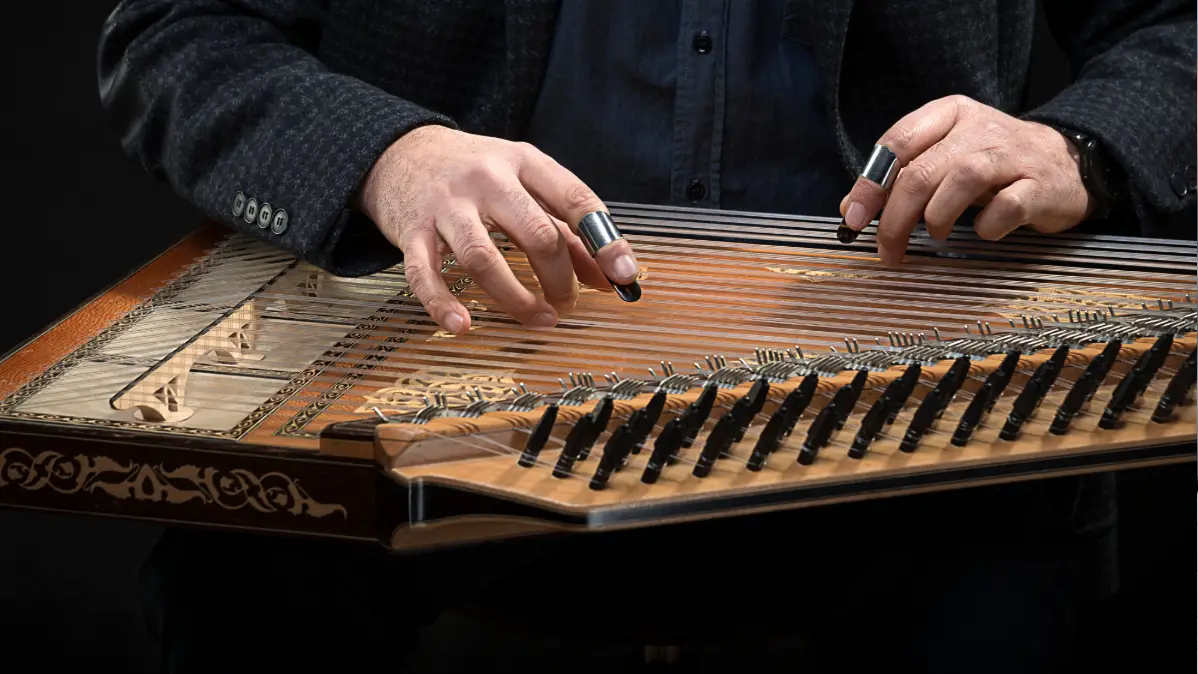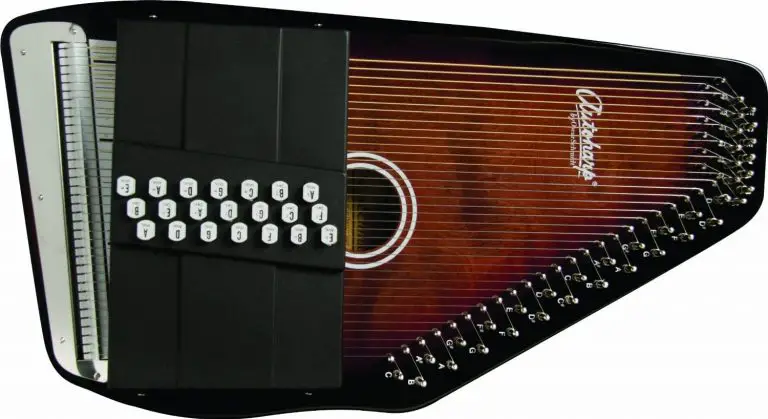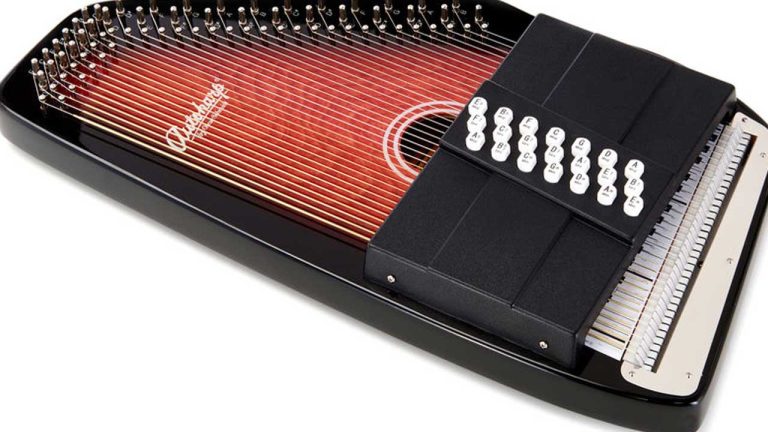Autoharp vs Zither: Comparing Stringed Instruments
Folkstrings.com is reader-supported. When you buy through links on our site, we may earn a small commission.
The autoharp and the zither are stringed instruments that have captivated musicians and audiences alike with their distinctive sounds and playing styles.
Although they may appear similar at first glance and indeed share common ancestry, each has unique characteristics that set it apart. The autoharp, with its series of chord bars and easy-to-play nature, allows even beginners to create harmonious music quickly.
In contrast, the zither, often associated with central European music traditions, offers a broader range of playing techniques. It relies on fingers or plectra to pluck individual strings.

While the autoharp is a modern adaptation equipped with a mechanism for chord playing, the broader family of zithers encompasses a variety of folk instruments without fingerboards. They are known for a melodious playing style that requires skillful direct string manipulation.
Both instruments have evolved over time, with developments reflecting changes in musical tastes and technological advancements in instrument making. Their enduring popularity is a testament to their versatility and the rich, textured sounds they can produce.
Key Points
- The autoharp and zither have unique features, despite looking similar.
- Autoharps facilitate chordal play, while zithers offer a range of playing techniques.
- Both instruments have evolved and continue to be popular due to their distinct sounds.
Table of Contents
Origins and History
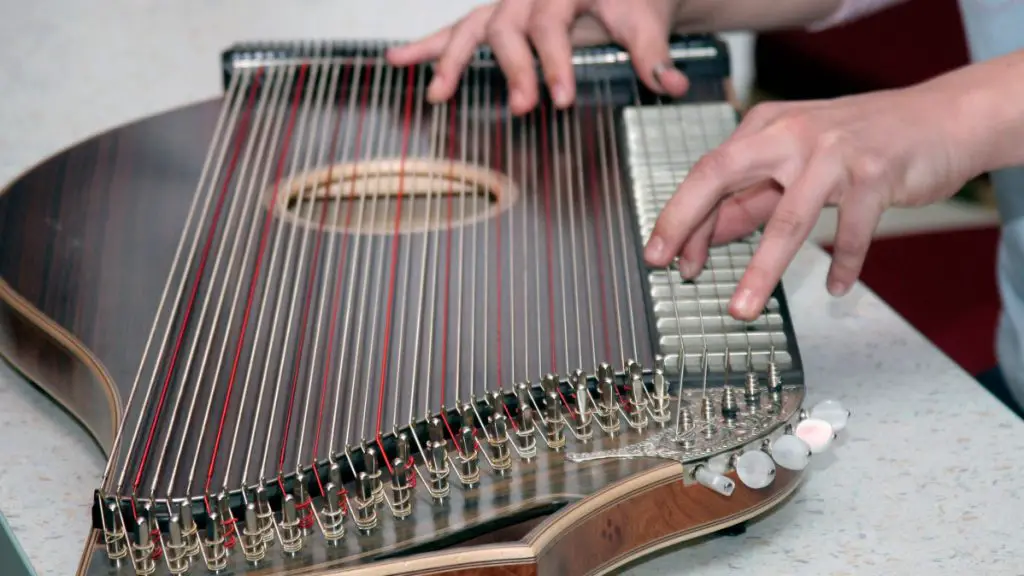
In exploring the origins and historical development of stringed instruments, I find the autoharp and zither to hold fascinating stories rooted in innovation and cultural significance.
Autoharp Evolution
The autoharp, which typically consists of a series of chord bars attached to a fretless zither, is a relatively recent invention compared to its cousin, the zither. My research shows that the autoharp was patented in 1882 by Charles F. Zimmerman, a German immigrant residing in Philadelphia.
With the aim of making music more accessible to the masses, Zimmerman’s creation was a hit. Interestingly, in 1894, Karl August Gütter obtained a patent in Germany for a similar instrument, which casts some doubt on who originally invented this instrument.
Zimmerman trademarked the name “autoharp” in the U.S., ensuring that the term became synonymous with his design. Even to this day, the autoharp is associated with American folk music, although it has experienced various modifications over time. The U.S. Music Corporation eventually acquired the trademark, and they continued to innovate and market the autoharp extensively.
Zither Development
Zithers, on the other hand, have a much older history that I find quite expansive. This family of musical instruments has roots that go deep into European musical traditions, particularly in Germany.
The zither’s basic form consists of multiple strings stretched over a resonating body, and it’s played by plucking or striking the strings. It was only later in history that fingerboards and chord mechanisms were added to create various zither derivatives.
Throughout the years, zithers have evolved into an assortment of shapes, sizes, and configurations, reflecting the rich cultural landscapes they are part of. There are numerous types of zithers, including the Alpine zither with fingerboards, and the concert zither that is larger and more complex.
The simplicity of the zither’s design allows for a range of musical expressions, which has made it a staple in folk traditions.
Design and Construction
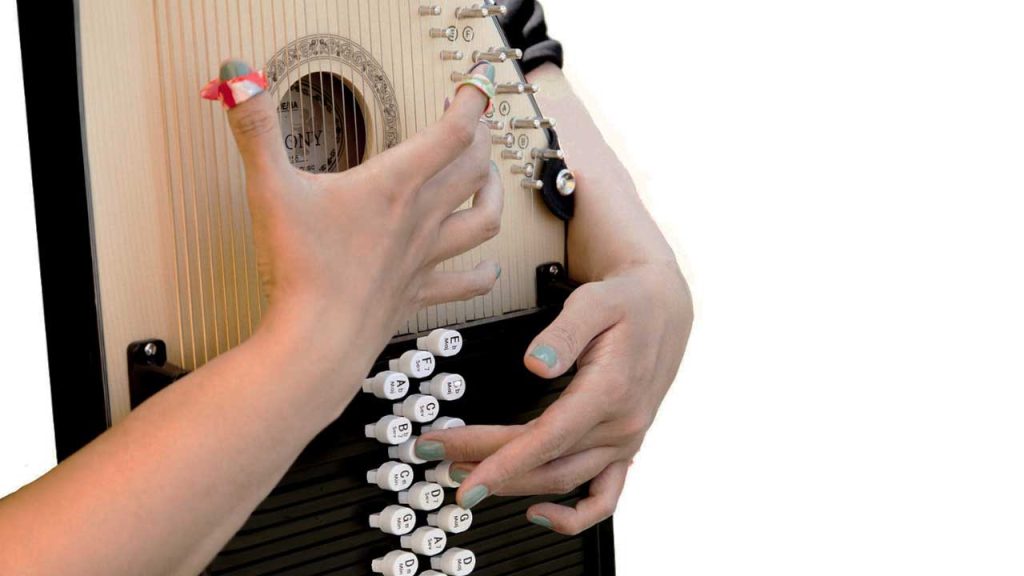
In comparing the autoharp and zither, I’ll focus on their unique design features and the construction elements that influence their sound and playability.
Autoharp Anatomy
My autoharp consists of a flat, wooden, usually rectangular body. At the heart of its design are chord bars across the top, each fitted with felt or foam pads to mute strings that are not part of the chord, allowing me to play chords by pressing buttons.
Beneath these bars, there are typically 36 strings anchored by tuning pins on a pin-block, with a range often fully chromatic across multiple octaves. The strings stretch over a soundboard, which, alongside metal bars and a combination of springs and dampers, amplifies the vibrations.
A plectrum or my fingertips pluck the strings, which can be strummed or picked to achieve a rich, harmonic accompaniment.
Zither Structure
When I turn my attention to the zither, I notice it is a more broadly defined category belonging to the zither family, which includes instruments like the hammered dulcimer, psaltery, and volkszither. The concert zither, one more specific manifestation, features a large, horizontally placed wooden body with a combination of open and fretted strings – played with a plectrum and the fingers of my right hand while my left hand presses the frets.
It often has a harpsichord-like, chromatic metal tuning system, with strings anchored by metal pins on one side. Some models like the akkordzither even include buttons as part of their construction, akin to those found on certain autoharps, for changing chords.
Zithers like the koto, guqin, and santur all share these foundational design principles, built around a wooden soundboard and strings stretched across a flat surface, which I play either with a plectrum or by striking or plucking with my fingertips.
Performance and Technique
Exploring the rich tapestries of the autoharp and zither reveals unique playing styles and methodologies integral to folk music traditions and beyond. Let’s delve into the specific techniques that make each instrument distinct.
Autoharp Playing Styles
My approach to the autoharp involves a variety of strumming and plucking techniques that are designed to accommodate its chordal nature.
This instrument typically features a series of bars with felt dampers that, when pressed, mute all the strings except those that form a particular chord, be it major, minor, or dominant seventh chords. This simplifies the formation of chords and enables a swift transition between them, which is particularly handy when performing vibrant folk music or even participating in grand events like the Grand Ole Opry.
I often employ a method developed by Maybelle Carter of the Carter Family, known as the ‘Carter scratch’. This technique combines a melody played on the bass strings with a rhythmic strum on the treble strings and is reflective of the instrument’s versatility in various musical realms.
An autoharp makes for an inviting entry point for beginners due to its straightforward method of producing harmonies and the forgiving nature of its chorded playstyle.
Zither Methodology
When discussing the zither, I must highlight its broader family, which includes the koto, hammered dulcimer, psaltery, and fretted dulcimers like the Appalachian dulcimer, each with their own methodologies.
Unlike the autoharp, many zithers like the Chinese guzheng or the Austrian Alpine zither do not have a damping mechanism. Thus, playing requires a more hands-on approach to achieve the desired sound.
In traditional zither play, the right hand plucks the strings with a plectrum or fingertips, while the left hand might use a fretted fingerboard, if present, to change the pitch of each note.
Tuning a zither can be a delicate process, often involving numerous strings that are tuned diatonically for specific music styles. The zither gained cinematic fame with Anton Karas’s “Harry Lime Theme” in The Third Man, where playful and suspenseful plucking articulates the versatility of this instrument’s playing style.
My personal experience has led me to appreciate the tactile feel of the zither’s strings under my fingers, which allows for expressive and dynamic playing. Whether in the context of folk music, a soundtrack, or a solo recital, my technique has evolved to encompass the careful timing and dexterity that the zither demands.
Cultural Impact and Legacy
In my exploration of musical instruments, I’ve found that both the autoharp and the zither have left a profound cultural imprint through their distinctive sounds in folk and popular music across various cultures.
Autoharp in American Folk
The autoharp, which I see as a fascinating instrument with an ability to resonate with the tactile simplicity of American folk music, owes much of its popularity to its association with the Carter Family. Mother Maybelle Carter brought the autoharp into the spotlight at the Grand Ole Opry and in their numerous recordings, often using it to accompany the family’s harmonies.
The instrument itself has German roots but was embraced by American folk music, particularly in the Appalachian region, where it became intertwined with the sounds of early country music.
The Carter Family, especially Maybelle, showcased the autoharp’s versatility in songs such as “Keep on the Sunny Side,” fundamentally shaping the identity of Appalachian music.
The autoharp could be considered an Americanized descendant of the German zither and shares similarities with instruments like the Appalachian dulcimer. This easy-to-play instrument is now synonymous with American folk music and continues to inspire musicians, from PJ Harvey to traditional folk artists, contributing to its enduring legacy.
Zither Across the World
The zither has a rich and diverse history that extends far beyond its German origins. Globally, the zither has played a significant role in folk music traditions.
In Europe, for example, the Akkordzither and its hometown of Markneukirchen highlight the instrument’s cultural significance. Anton Karas catapulted the zither to international fame with “The Harry Lime Theme” from the film The Third Man.
Meanwhile, in places like Hawaii, adaptations of the zither merged with local traditions to create unique musical experiences.
As I look further afield, I find that variants of the zither, such as the Chinese guqin, have been integral to the musical landscapes of countries like China and India, enriching classical and folk genres.
Frequently Asked Questions
In this section, I’ll address some of the most common questions about autoharps and zithers. I’ll cover their differences, suitability for beginners, versatility, price, playing techniques, and notable pieces that feature these instruments.
What characteristics differentiate the sounds of an autoharp versus a zither?
The autoharp is known for its rich, full chords. These chords are made easy by pressing chord bars that mute all strings except those that form the desired chord. By contrast, the zither offers a more direct and straightforward sound. It relies on individual string plucking and fingering for melodies and chords.
For beginners interested in plucked string instruments, should they start with an autoharp or a zither?
I would say it depends on personal preference and musical goals. The autoharp can be appealing for its immediate chordal accompaniment. Meanwhile, the zither often provides a simpler and more hands-on approach to learning melody lines and basic finger-picking techniques.
Which one is more versatile for different music genres: an autoharp or a zither?
The autoharp, with its range of chord bars, adapts well to various genres that utilize chord progressions, such as folk, country, and pop. The zither, however, with its free-string layout, offers flexibility across classical, traditional, and experimental music.
What are the typical price ranges for autoharps and zithers?
Autoharps might come in the range of $100 to $500 for basic models, but custom or high-end options can exceed $1000. Zithers, depending on the type and craftsmanship, can vary widely in price. Simple versions can start at about $50, while concert-quality instruments can cost several hundred dollars.
Can you explain how playing techniques vary between an autoharp and a zither?
Playing an autoharp involves strumming or picking strings while managing chord bars for harmonies. On a zither, my technique involves both hands plucking individual strings or combining finger picks for playing melody and accompaniment. Sometimes, I also use complex finger positions.
What are some popular songs or pieces that feature an autoharp or a zither?
Classic American folk music often showcases the autoharp. June Carter Cash is a notable player. Mainstream songs like “Goodnight, Irene” use the autoharp.
For the zither, the “Third Man Theme” from the film “The Third Man” is a well-known piece that highlights the instrument’s unique sound.
Author Profile
-
Daniel Johnstone is an English writer with a love for stringed instruments from around the world.
He shares his love for these instruments through his writing for folkstrings.com, a website dedicated to all things related to folk string music.
Daniel's passion for music started at a young age, and he has since become an accomplished musician, playing guitar, cavaco, and recently, the harp.
His dedication to learning and sharing his knowledge of stringed instruments is evident in his insightful and engaging blog posts. Whether you're a seasoned musician or a beginner, Daniel's writing is sure to inspire and entertain you.
When he's not playing music or writing, you can find Daniel exploring new instruments and seeking out new sounds to share with his readers.
Latest entries
 AutoharpApril 4, 2024What Is the Autoharp Made Of: Exploring Its Materials and Craftsmanship
AutoharpApril 4, 2024What Is the Autoharp Made Of: Exploring Its Materials and Craftsmanship AutoharpApril 4, 2024Is Autoharp Easy to Play? Unveiling the Truth for Beginners
AutoharpApril 4, 2024Is Autoharp Easy to Play? Unveiling the Truth for Beginners AutoharpApril 4, 2024What Is an Autoharp Worth? Your Guide to Pricing and Value
AutoharpApril 4, 2024What Is an Autoharp Worth? Your Guide to Pricing and Value AutoharpApril 4, 2024Are Autoharp and Zither the Same Thing? Unraveling String Instrument Myths
AutoharpApril 4, 2024Are Autoharp and Zither the Same Thing? Unraveling String Instrument Myths
Affiliates:
This post may contain affiliate links that at no additional cost to you, the site may earn a small commission. We only recommend products we would use ourselves and all opinions expressed on this site are our own.
Accuracy Advice:
While we strive to provide up-to-date and accurate information, the content in this article may not reflect the most current research or medical guidelines. We encourage readers to do further research and consult with professionals for more personalized advice.
Our Recommendations:
The products and services mentioned in any of our articles are recommended based on our independent research and personal experience. We are not sponsored by any company. We aim to suggest products and services we believe are of high quality and could be beneficial to our readers.

